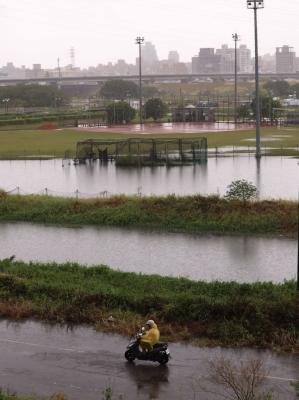Lockheed Martin and Raytheon are "viable" candidates to team with either Northrop Grumman or General Dynamics in building diesel submarines for Taiwan, a top US Navy admiral said.
The Navy will ask the companies for proposals within two months of receiving Taiwan's commitment for the money to design and build up to eight diesel submarines, Rear Admiral John Butler, the Navy program executive officer for submarines, said.
The George W. Bush administration offered Taiwan the submarines in 2001 as part of an arms package to counter the threat from China. China has 69 attack submarines; Taiwan has four.
The package -- which includes anti-submarine reconnaissance aircraft, four destroyers and missiles -- has been delayed as lawmakers debate defense spending.
Butler's comments to reporters in Washington are the first update on the issue in months. He said Navy officials in Taiwan say they can't commit funds until 2006 and Raytheon and Lockheed will vie to help build the submarines.
Northrop and General Dynamics, the only two US makers of submarines, will compete for the work.
"I expect the two shipbuilders to team up with whoever they want," Butler said.
The program's value hasn't been estimated.
Butler said the four companies were briefed on the Navy's notional plans. Lockheed and Raytheon participate in numerous Navy programs as systems integrators of complex electronic combat systems, radar, fire control and combat identification.
"The Taiwanese said last month that they don't believe they can get the money obligated against this program before 2006," Butler said.
"We believed that they would obligate funding in 2004 and we were ready to go in 2004," he said. "If they get us those funds earlier, we'll back the schedule up."
"We are certainly interested but we haven't teamed with any hull-maker at this time," said David Shea, a Raytheon spokesman.
"We are very interested in participating in the Taiwan submarine program," Lockheed Martin spokesman Jeff Adams said, without elaboration.
Northrop Grumman would build the submarines at its Pascagoula, Mississippi, facility and is still exploring its options as to US teammates and potential foreign subcontractors, Randy Belote, a company spokesman said.
General Dynamics' Electric Boat unit, Groton, Connecticut, is also exploring its options but hasn't determined where the submarines would be built, Neil Ruenzel, a EB spokesman said.
US President George W. Bush "made a commitment to help Taiwan procure its diesel-electric submarines," Pentagon spokesman Commander Jeff Davis said. "That was a commitment made in earnest and we intend to deliver on it."
Taipei has yet to commit funding for any of the major weapons programs Bush proposed in the April 2001 package although they are close to advising the Pentagon they plan to buy the destroyers, Lieutenant General Tome Walters, the director of Defense Security Cooperation Agency, said in an interview.
Legislators have been debating how much to spend on defense and what systems should be procured first, according to Shirley Kahn, an Asia affairs expert with the non-partisan Congressional Research Service.
The submarines, for example, were estimated by officials to require at least US$4.5 billion, the most costly element of the April 2001 package, Kahn said. The four Kidd-Class destroyers were estimated to cost about US$800 million, she said.

TRAFFIC SAFETY RULES: A positive result in a drug test would result in a two-year license suspension for the driver and vehicle, and a fine of up to NT$180,000 The Ministry of Transportation and Communications is to authorize police to conduct roadside saliva tests by the end of the year to deter people from driving while under the influence of narcotics, it said yesterday. The ministry last month unveiled a draft of amended regulations governing traffic safety rules and penalties, which included provisions empowering police to conduct mandatory saliva tests on drivers. While currently rules authorize police to use oral fluid testing kits for signs of drug use, they do not establish penalties for noncompliance or operating procedures for officers to follow, the ministry said. The proposed changes to the regulations require

Taipei, New Taipei City, Keelung and Taoyuan would issue a decision at 8pm on whether to cancel work and school tomorrow due to forecasted heavy rain, Keelung Mayor Hsieh Kuo-liang (謝國樑) said today. Hsieh told reporters that absent some pressing reason, the four northern cities would announce the decision jointly at 8pm. Keelung is expected to receive between 300mm and 490mm of rain in the period from 2pm today through 2pm tomorrow, Central Weather Administration data showed. Keelung City Government regulations stipulate that school and work can be canceled if rain totals in mountainous or low-elevation areas are forecast to exceed 350mm in

The Executive Yuan yesterday announced that registration for a one-time universal NT$10,000 cash handout to help people in Taiwan survive US tariffs and inflation would start on Nov. 5, with payouts available as early as Nov. 12. Who is eligible for the handout? Registered Taiwanese nationals are eligible, including those born in Taiwan before April 30 next year with a birth certificate. Non-registered nationals with residence permits, foreign permanent residents and foreign spouses of Taiwanese citizens with residence permits also qualify for the handouts. For people who meet the eligibility requirements, but passed away between yesterday and April 30 next year, surviving family members

1.4nm WAFERS: While TSMC is gearing up to expand its overseas production, it would also continue to invest in Taiwan, company chairman and CEO C.C. Wei said Taiwan Semiconductor Manufacturing Co (TSMC) has applied for permission to construct a new plant in the Central Taiwan Science Park (中部科學園區), which it would use for the production of new high-speed wafers, the National Science and Technology Council said yesterday. The council, which supervises three major science parks in Taiwan, confirmed that the Central Taiwan Science Park Bureau had received an application on Friday from TSMC, the world’s largest contract chipmaker, to commence work on the new A14 fab. A14 technology, a 1.4 nanometer (nm) process, is designed to drive artificial intelligence transformation by enabling faster computing and greater power